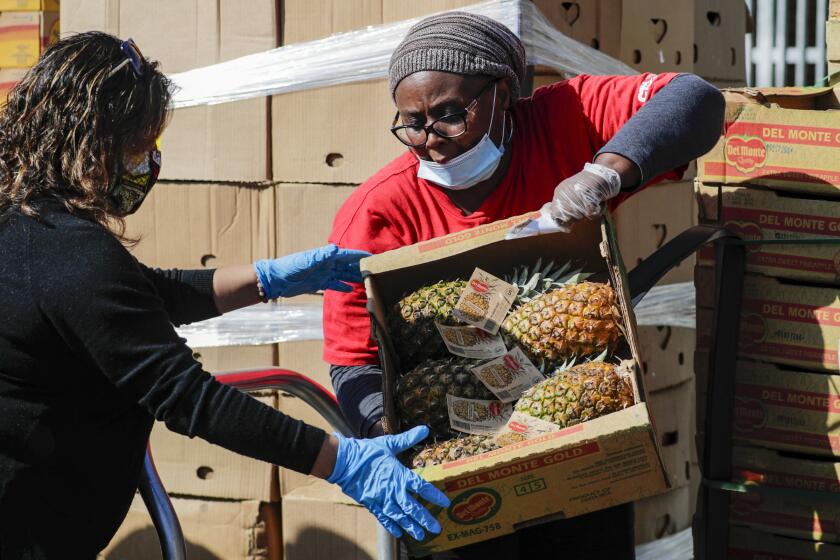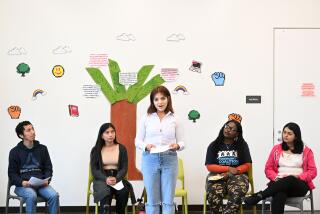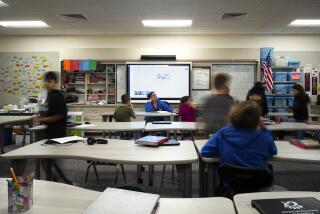Op-Ed: Distance learning? Even my students will tell you that’s not the future

- Share via
In the past few weeks, many of my high school students have sent me emails apologizing profusely for not turning in the work I assigned, for not watching the videos I made, and for not responding to the many emails I sent.
My 9-year-old son loudly and passionately bemoans yet another Zoom meeting. My teen daughters, who have morphed into nocturnal vampires as this quarantine stretches from weeks to months to goodness-knows-how-long, keep asking me “what’s the point?” They know the best grade they can get in their classes is a banal “pass.”
No one seems motivated at the moment. No one is enjoying the learning process. No one finds this new paradigm of isolated learning — Zoom meetings without end, YouTube videos and gazing at pixilated screens all day — to be a powerful catalyst for academic growth.
But the future is what really worries me.
In the coming era of cataclysmic budget cuts to education, this educational experiment under crisis conditions could be exploited to pioneer a new era of instruction, one in which the presence and power of traditional classroom teaching is permanently swapped in favor of distance or hybrid instruction requiring far fewer teachers.
The temptation for those in charge of education budgets could be strong. After all, school facilities are expensive to build and maintain. Teachers are expensive to employ. Education policymakers may already be thinking, “Zoom meetings can host dozens and hundreds of people at the same time. Why do we need so many teachers?”
Moving away from a traditional classroom setting in which a living, breathing human being teaches and interacts with students on a daily basis would be a colossal and catastrophic mistake.
Even before the quarantine, modern students isolated themselves more — going to fewer football games and dating less, and engaging in more online socializing — than any generation in American history. Before the coronavirus lockdown, they were more likely to report mental health conditions than any other generation, according to an American Psychological Assn. survey. Their rates of depression, anxiety and the propensity for self-harm doubled between 2007 and 2018.
Physically attending school has hidden benefits. Getting up every morning, learning to obey the tyranny of the alarm clock, interacting with other students, and fostering relationships with teachers might not be akin to ascending Mount Olympus, but they are essential skills to cultivate in young people.
Moreover, we have decided as a civil society that schools should be much more than simple institutions of traditional learning. Schools are now places that provide meals. They are refuges where students receive counseling and other social-emotional support.
Schools have become the ultimate backstop for many of society’s failures. When districts were forced to quickly shut down, school officials around the state did not appear to be publicly fretting about algebra or history classes. They worried about how to make sure the children would get fed every day.
Help the Los Angeles Times reimagine what California should look like after the COVID-19 pandemic ends.
Lawmakers and technocrats are often intoxicated by the latest technology in education, enchanted by the potential to “transform” education overnight or make schools hives of policy experimentation. But using Google Classroom does not empower a teacher to keep a struggling student after class to ask, “What’s wrong?” YouTube videos can’t make eye contact or gauge a student’s level of engagement. Zoom meetings will never capture the tactile nature of powerful teaching that exists on a personal level.
Yet we live in a world and in a time where the most important adult relationship for many school-age children is with their teacher.
When I began teaching more than two decades ago, I never imagined I would have students tell me, “No one in my home cares about my success the way you do.” I never thought I would hear stories from the young men in my classes about physically protecting their mothers or younger sisters from abusive live-in boyfriends. Or that my students would ask me to attend senior awards assemblies because they had no other adult they could count on to show up.
These brutal realities make an appearance in the classroom almost every day. In their first 18 years of life, children spend only 9% of their time in school. Yet teachers are expected to socialize children, prepare them to be responsible citizens, cultivate interpersonal skills, encourage successful time management, and fortify students’ capacity to flourish in an increasingly harsh labor market.
Given these expectations, school should not become permanently more “remote.”
Let us not forget that the wonderment of the classroom, the source of its transformative possibilities, is rooted in the humanity of the people gathered in the same place, at the same time. The best teachers are not maestros of education apps or virtuosos of virtual instruction. They are savants of human transformation because of their capacity to forge powerful connections with their students, inspire their best efforts, and engage them in meaningful and personal ways.
There are no shortcuts on the path to changing a human life, no technological panaceas. Powerful teaching is about an adult believing in us, showing us a higher path. If some of us see stars it is often because a teacher tilted our heads toward the heavens.
Ask students what they think about the last two months of instruction — from kindergarten to college — and the overwhelming response is that the magic of the classroom is lost when it becomes a process carried out over impersonal, awkward platforms.
Technology, no matter how advanced, should simply be a tool, an additional arrow in the pedagogical quiver of teachers.
Please, for the sake of our children and their futures, do not mistake technology for the power and poignancy of an effective teacher.
Jeremy Adams is a high school and college political science teacher in Bakersfield, and author of “Riding the Wave: Teacher Strategies for Navigating Change and Strengthening Key Relationships.”
Handing out food, hunting down students, organizing distance learning. This is one day in the life of an Inglewood teacher during the coronavirus crisis.
More to Read
A cure for the common opinion
Get thought-provoking perspectives with our weekly newsletter.
You may occasionally receive promotional content from the Los Angeles Times.












